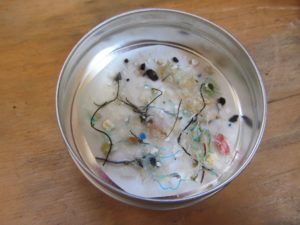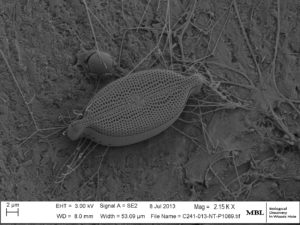During its passage across the Pacific Ocean between Concepcion and Tahiti, Race For Water is continuing its commitment to science. Indeed, by taking regular samples of water, the crew of the Race For Water Odyssey is contributing to the analysis of the microorganisms living in the vicinity of plastic marine waste. The zones where plastics accumulate in the open ocean, like those in the middle of the Pacific Ocean, are making the development of a new ecosystem possible: the plastisphere. Bacteria, green algae and even the small organisms making up plankton are developing and living thanks to the presence of marine waste. Which species make up the plastisphere, how do they interact and, above all, do they affect the natural cycle of life in the oceans? The Race For Water Foundation, anxious to assist scientific research, will be participating in this international study programme. Explanations.
Microorganisms, more commonly referred to as microbes, form the basis of any biological or chemical cycle. At sea, they enhance the development of algae, enabling the harnessing of CO2 and favouring the development of a concentration of marine biomass by attracting small fish and other marine mammals feeding on it.
1,000 species of microbes on one piece of micro-plastic
Whilst the appearance of this microbial life at the heart of the oceans was naturally difficult and rare in the past, the accumulation of plastic waste in the sea has changed this reality. Through the discovery of the presence of over a thousand species of microorganisms on a single, miniscule piece of plastic collected at sea, experts have quickly formed a theory about the development of a new ecosystem at the centre of the oceans, there are large areas of the ocean where we find accumulations of small pieces of plastic. “Within the oceanic gyres, like those close to the coast, we want to understand which organisms make up what we’ve called the plastisphere and what impact they have on the marine environment”, explains Linda Amaral-Zettler, microbiologist at the Royal Netherland Institute for Sea Research (NIOZ) and the director of the Plastisphere research project.
In order to understand which species of microbes are present, the scientists are analysing the DNA contained in the various water samples. Indeed, the way in which these microorganisms live together in an environment made up of plastic waste is unique and every oceanic zone is different. “We need a large number of water samples from a variety of geographical zones in order to study the microbial interaction. Of course, near the coast, collection is easier than in the middle of the oceans”, says Linda Amaral-Zettler. As such, the scientist is delighted: “The help of the Race For Water Foundation during its crossing of the Pacific will provide us with precious data”.
The crew at the service of science
Trained by the scientists from the NIOZ, members of the crew of the Race For Water Odyssey will collect the water every two days. As such, geographical coordinates and sea state will be annotated to provide the scientists with more information. During the crossing, the samples will be stored in the Race for Water laboratory then, once back on shore, they will be sent to the Dutch study centre. “The collection of water samples and their storage do not involve simple protocols. This will require the utmost rigour, because you have to try not to damage the DNA particles. Furthermore, the number and size of the micro-plastics present in the water greatly influences the diversity of the microbes. To have robust results, we need a lot of samples”, explains the microbiologist. In order to stick to this protocol with the utmost reliability, a test and training phase for the crew of Race For Water will take place during the sailing, which links Lima in Peru to Valparaiso in Chile.
 What typical plastic marine debris from a net tow looks like
What typical plastic marine debris from a net tow looks like
(high density plastic region) Copyright : Erik Zettler
Raising awareness for the action
For Erik Zettler, a scientist associated with the Plastisphere research project, it is also essential to inform populations about the importance of microbial life and its link with marine waste. “Yes, plastic bags floating in the environment are dangerous and deadly for animals that ingest them. However, they cease to have this impact once they deteriorate into micro-particles. At that point, they have an impact on the entire microbial ecosystem, the basis of the food chain for the biological and chemical cycles of oceans”.
 A scanning electron microscope image of a diatom (single called photosynthetic organism) on a piece of plastic from the ocean
A scanning electron microscope image of a diatom (single called photosynthetic organism) on a piece of plastic from the ocean
As a result, the Plastisphere study makes it a point of honour to spread the word about this issue among the widest possible audience. The results will be made public and will be open to any other study wishing to benefit from the data. “What the Race For Water Odyssey is doing in terms of raising awareness is key, because we must take action on land”, concludes the researcher.